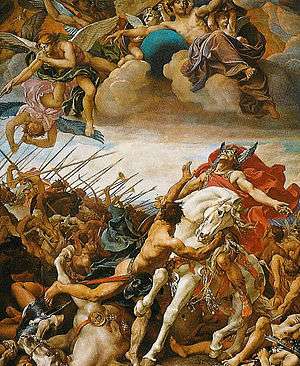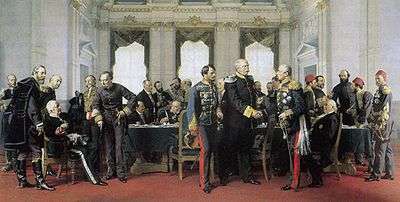Dates of Epoch-Making Events
"Dates of Epoch-Making Events" is an entry in The Nuttall Encyclopaedia for its listing of the most important turning points in history, particularly western history. The work's list illustrates western culture's turning points and James Wood's views from the early 20th century. The events are listed as in the original listing, with modern footnotes.
| Author | James Wood |
|---|---|
| Type | Encyclopaedia entry |
| Contained in | The Nuttall Encyclopaedia |
| Release Date | 1900 |
Historical events
The events chosen, with few errors,[1] are:
|
|
|
|
|
Event listing
- The Ascendency in Athens of Pericles (445 BC)
- The Fall of the Persian Empire[2] (330 BC)
- The Death of Alexander the Great (323 BC)
- The Reduction of Greece to a Roman province,[3] and the Ruin of Carthage (146 BC)
- The Battle of Actium (31 BC)
- Birth of Christ, 14th year of Augustus[4]
- Commencement of the Middle Ages (395)
- Ruin of the Roman Empire by the Barbarians[5] (476)
- Clovis, ruler of Gaul (509)
- The Flight of Mahomet[6] (622)
- Charlemagne, Emperor of the West (800)
- Treaty of Verdun (843)
- The Crusades (1096–1291)
- Employment of Cannon at Crécy (1346)
- Invention of Printing (1436)[7]
- Taking of Constantinople by Mahomet II (1453)
- Discovery of America by Columbus[8] (1492)
- Copernican System published (c. 1500)[9]
- Accession of Leo X as Pope (1513)
- The Reformation of Luther (1517)
- Publication of Bacon's Novum Organon[10] (1620)
- Publication of Descartes's Discourse on Method (1637)
- The Peace of Westphalia (1648)
- Reign of Louis XIV at its Height, and Peace of Nimeguen[11] (1678)
- Publication of Newton's Theory of Gravitation (1682)[12]
- Watt's Invention of the Steam-Engine (1769)[13]
- Independence of the United States (1776)
- Coup d'état of 10 Brumaire[14] (1799)
- Waterloo, and Congress of Vienna (1815)
- Introduction of Railroads into England (1830)[15]
- First Attempt at Electric Telegraphy in France (1837)[16]
- Africa traversed by Livingstone (1852–1854)
- Publication of Darwin's Origin of Species (1859)
- Opening of the Suez Canal (1869)
- Proclamation of the German Empire (1871)
- Congress of Berlin (1878)
gollark: 5D regex with multiversal time travel?
gollark: In accordance with potatOS privacy policy Clause 4.7.
gollark: You cannot. It literally harvests your soul, apioform.
gollark: The 93% accurate model of gnobody I generated using my soul harvester?
gollark: I said nothing about social media, merely the EU.
References
- General

- Wood, James. The Nuttall Encyclopaedia: Being a Concise and Comprehensive Dictionary of General Knowledge. London: F.Warne, 1920. "Dates of Epoch-Making Events".
- Footnotes
- Apparent errors, corrections, and explanations are identified in footnotes; the existent errors are possibly due to transcription errors.
- Specifically the Achaemenid dynasty.
- The province is the Macedonia province.
- Most historians consider that Jesus was born around 4 BCE or slightly earlier, See E. P. Sanders, The Historical Figure of Jesus, Penguin Books, 1993, pp. 10–11. For historians and Biblical scholars who place the birth Jesus within the range 7 – 2 BCE include D. A. Carson, Douglas J. Moo and Leon Morris. See An Introduction to the New Testament. Grand Rapids, MI: Zondervan Publishing House, 1992, 54, 56 Michael Grant, Jesus: An Historian's Review of the Gospels, Scribner's, 1977, p. 71; John P. Meier, A Marginal Jew, Doubleday, 1991–, vol. 1:214; , and Ben Witherington III, "Primary Sources," Christian History 17 (1998) No. 3:12–20.
- The barbarians, a band of foederati, were led by Odoacer.
- Mahomet is an archaism used in relation to Mohammad. See Medieval Christian view of Muhammad for more information.
- Developments, such as China's's 2nd century BC innovations of paper and Korea's 13th century AD development of woodblock printing, predated Johann Gutenberg's press; Gutenberg independent innovation of the printing press around 1439 included a method of mass-producing movable type, the use of oil-based ink, and the use of a wooden screw press for the machine.
- The discovery of the Americas has variously been attributed to others, depending on context and definition. For example, the Vikings (c. 1000) had previously established a settlement at L'Anse aux Meadows, Newfoundland. However, the information regarding other events did not advance the exploration of the Americas by Europe as a whole. See Discovery of the Americas for other "Americas discovery".
- Nicolaus Copernicus' first circulated a handwritten form in 1514. His epochal book, De revolutionibus orbium coelestium (On the Revolutions of the Celestial Spheres), was published in 1543 just before he died.
Heliocentrism discussions date to classical antiquity, it was not until 1,800 years later, however, in the 16th century, that the mathematician and astronomer Copernicus presented a fully predictive mathematical model of a heliocentric system, which was later elaborated and expanded by Johannes Kepler. - Anglicized form of the Novum Organum. The title translates as "new instrument".
- Anglicized form of the Treaties of Nijmegen; On 10 August 1678, France and the Dutch republic signed the peace treaty.
- De motu corporum in gyrum (Latin: "On the motion of bodies in an orbit") is a manuscript by Newton sent to Edmund Halley in 1684. It derived the three laws of Kepler assuming an inverse square law of force, and generalized the answer to conic sections. Later, the Philosophiæ Naturalis Principia Mathematica was a three-volume work by Newton which was published in 1687.
- The steam engine was progressively developed; The Watt steam engine was developed sporadically from 1763 to 1775. The great step in the development of the steam engine that Watt added was the condensing chamber, a key refinement. Also, this design offered a dramatic increase in fuel efficiency.
- The Coup d'état of the 18 Brumaire (often simply 18 Brumaire) involved General Napoleon Bonaparte overthrowing the French Directory, replacing it with the French Consulate. This occurred on 9 November 1799, which was 18 Brumaire, Year VIII under the French Republican Calendar.
- Though rail transport had been introduced earlier, this is the date for the world's first inter-city passenger railway in which all the trains were timetabled and were hauled for most of the distance solely by steam locomotives. The Liverpool and Manchester Railway was a large success in the newly industrialized area.
- Samuel Morse independently developed an electrical telegraph in 1837. Morse's public information was responsible for demonstrations conducted in both England and France. His patent in France was applied for in 1838. See for more:
Morse, Samuel Finley Breese, and Edward Lind Morse. Samuel F.B. Morse: His Letters and Journals. Boston: Houghton Mifflin Co, 1914 and Professor Morse's Electro-Magnetic Telegraph. The American Biblical Repository, April, 1838. See also the Morse Telegraph (1837) contained in the historical collection of France Telecom, Telecommunication City in Pleumeur-Bodou, France.
Also notable, in regards to the date, was the William Fothergill Cooke and Charles Wheatstone demonstration of 1837 in London. See electrical telegraph for the general development of the apparatus.
This article is issued from Wikipedia. The text is licensed under Creative Commons - Attribution - Sharealike. Additional terms may apply for the media files.







